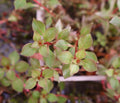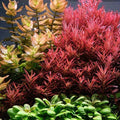The 5 Best Plants for Goldfish Tanks
Here’s our list of hardy and goldfish-friendly plants to spruce up your aquarium:
1. Java Fern
One of the best aquarium plants to grow in a planted aquarium is a Java fern. You may choose from large, tall, long-leafed types, as well as thin, narrow, and the elegant crest-leafed varieties. One of my all-time favorite aquarium live plants is the Java fern, which requires no CO2 supplements and thrives in low light levels.
Goldfish find its rough, fibrous leaves unpleasant, and it grows best when affixed to rocks or driftwood. Bonus: It works well with tanks that have plain bottoms!
2. Java Moss
One of the greatest aquarium plants for beginners is Java moss. In addition to being inexpensive and almost unbreakable, it also minimizes nitrates, looks attractive, and offers excellent cover for fish fry. If cultivated in medium or low light, Java Moss doesn't need any CO2 supplementation.
This adaptable, rootless plant uses rhizoids to adhere to a variety of surfaces. It can float freely or be used as a wall covering or carpet. Java moss grows swiftly and bounces back effectively after slight damage, however goldfish may nibble on it.
3. Anubias
The greatest plant for your freshwater fish tank, in my view, is an anubia. Anubias is easy to maintain, resilient, and versatile. To grow and flourish in an aquarium, anubias don't require any unique conditions, such as particular lighting or carbon dioxide.
Anubias can be grown on wood, rock, or other hard surfaces, and they can be submerged or emersed. They don't need a substrate to grow, however they can also be grown on gravel or dirt. Anubias grows best when affixed to rocks or driftwood, making it perfect for goldfish tanks. Its stiff leaves, which goldfish usually disregard, allow it to flourish in low-light conditions. To prevent rot, keep the rhizome exposed.
4. Moss Balls (Marimo Moss)
Moss balls, which are low-light, slow-growing plants that are technically classified as algae, aid in keeping tanks clean by absorbing nitrates and supporting good bacteria. Although some goldfish could eat them, moss balls are durable and little maintenance. Marimo balls can lower nitrate levels in aquarium environments.
Through their surface, they absorb nutrients, such as nitrates, which can help to enhance the quality of the water. Marimo moss balls do best at colder water temperatures between 65°F and 78°F (18°C and 25°C). Extreme temperature changes should be avoided since this might stress the plants and have an adverse effect on their health.
5. Vallisneria sp. Gigantea
Vallisneria sp. Gigantea from Asia is a fast-growing, easy-care plant that works well in large aquariums. The majority of aquariums have leaves that are so long (50–150 cm, 2 cm broad) that they float on the water's surface.
Pruning is therefore necessary to prevent the plant from absorbing too much light from plants growing below it. Typically, herbivorous fish do not consume the leaves due to their strength and toughness.
Plant it in small bunches about an inch thick in the substrate, fertilize it frequently, and it will take over that tank in a few weeks. It's probably the simplest aquarium plant and can adapt to almost any water condition.
















